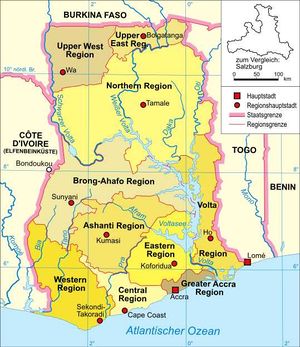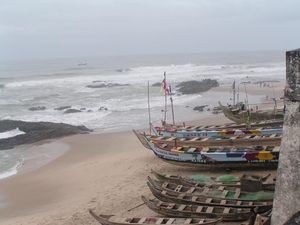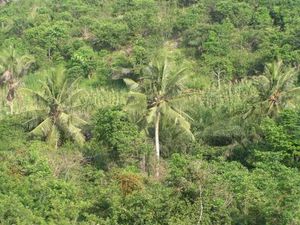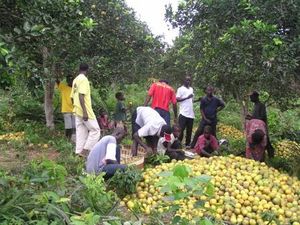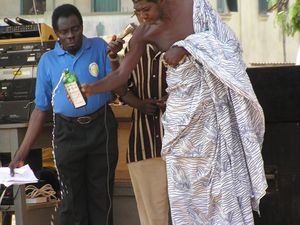Ghana
Ghana is a state in West Africa, bordering the North Atlantic Ocean between Côte d’Ivoire and Togo. On an area of more than 230,000 km², it has 18.5 million inhabitants (Census 200).
In colonial times, the country was called “Gold Coast”. The Nkrumah government chose the name “Ghana” in 1957, the year of independence, referring with admiration to the ancient state of “Gana” on the territory of today’s Mali.
The Ghanaian flag is a result of a competition, announced by a newspaper in 1957. Mrs. Theodosia Okoh, who won the competition, is the creator of the flag. She suggested red for those who died in the struggle for independence, gold for the wealth of the country and green for the forest. The black star in the centre is the symbol of African freedom.
Geography
Regions
The Ghanaian Regions with their capital are:
- Ashanti Region – Kumasi
- Greater Accra Region - Accra
- Eastern Region – Koforidua
- Northern Region – Tamale
- Western Region – Sekondi-Takoradi
- Brong-Ahafo Region– Sunyani
- Volta Region – Ho
- Central Region – Cape Coast
- Upper East Region – Bolgatanga
- Upper west Region – Wa
Climate
Ghana is located on the Gulf of Guinea, slightly north of the equator, which just crosses Ghanaian waters, but not the land. The country had more than 500km of sandy beach. The climate is tropical. In the southern parts, there are rain forest belts. In the north, there is savannah.
In January, a sandy wind goes across the whole country, the “Harmattan”.
Along the coast, farmers have one harvest a year. Only fifty kilometres northward, a fertile belt begins with two harvests a year. The northern regions with their dry climate are not as fertile as the southern zones.
Population
The Akan people forms the biggest part of the Ghanaian population with a share of about 50%. Other peoples are Mole-Dagomba, Ewe (a people living in Ghana and Togo) and Ga-Dangme.
The literacy rate is 74.8%, the female literacy rate only 67.1%.
Culture
Religion
Christian religion is prevailing (69%), followed by Muslims (15.6%) and Natural religions (8.5%). Most of the Muslim population is to be found in the north. Ghanaians are very tolerant, so that in official ceremonies, representatives of all three main beliefs hold a short service. Traditional religion plays a much bigger role than the statistics make believe. Lots of Christians and Muslims pour libations for their ancestors.
The ancient Akan religion is monotheistic; their God is called “Nyame”. This word is also used for the Christian and the Muslim God. The Akan believe that nature is animated by certain spirits. These spirits are living in trees, in the water or in other places they may find comfortable. The spirits can be located. In this case, if it is a tree, for example, a stone ring is built around the residence of the spirit, who receives libations and food sacrifices from time to time. If the tree has to be cut, the spirit must be asked before to move to another tree.
The veneration of the ancestors plays an important role. They are living in a world between the human world and God and they are able to mediate. The ancestors also receive sacrifices.
History
4th until 13th century – Ancient Empires
As written sources are scarce, it is very difficult to write about older Ghanaian History. We have excellent sources from Arab writers about the ancient empires of (ancient) Gana, Songhai and (ancient) Mali, situated on today’s territory of Mali, Mauritania and Senegal. Those empires were incredibly rich and had a very rich culture.
Many of the Ghanaian peoples claim to be descended from the peoples who formed those ancient empires. This theory is not proved. Other theories say, the inhabitants of modern Ghana came from old Egypt. This is also but a vague theory.
Arab sources do not give any hint to the origin of Akan, Ewe and others. What happened on Ghanaian territory during that early time cannot be reconstructed. There is still a lot to do for archaeologists.
13th until 18th century – Migrations
There were several migration movements from north to south throughout the centuries. The intruders did not come into unsettled land. When the Europeans arrived, there were battles and dissension between the indigenous inhabitants.
15th until 20th century – Colonialism
As a result of the activities of the Portuguese king Henry the Navigator (1394-1560), a Portuguese expedition arrived on the Gold Coast in 1471. There aim was to find trade partners. In 1482, the Portuguese castle “Elmina” (The mine) was built. It is possible, that Christopher Columbus spent some time there in 1492 on his famous expedition. Very fast, the colonial powers turned to slave trade. In 1502, the first slave ship left the West African coast. The European traders bought most of the slaves from indigenous peoples.
During the centuries, the colonial powers changed. Sometimes, the territory was divided, then all of the country was in one hand. The different colonial powers were mainly Portuguese, Dutch and English. There were also Danish, German and other influences.
from 1957 – Independence
As the first sub-Saharan country, Ghana gained independence in 1957. The first president of the young republic was Kwame Nkrumah.
Politics
The country has a solid democracy and is very peaceful. Representatives of the government are often asked to mediate in other countries.
The present head is president John Agyekum Kufuor.
Currency
Since July 2007, the new currency is "Ghana Cedi". One new "Ghana cedi" is 1000 old Cedis. "Cedi" is the Akan word for cowry shell. The small unit is "Pesewa".
